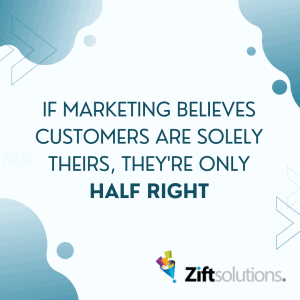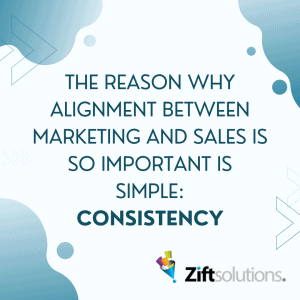If you aren’t asking it yet, there’s a crucial question to begin raising with your channel partners when it comes to achieving marketing and sales alignment:
“Do the people who are responsible for marketing in your organization know who their customer is?”
Their salespeople do. Anyone in sales knows who buys from them. They know what those customers buy. If they’re really good at it, they even know why their customers buy. But no matter what, salespeople understand who customers are.
If marketing believes customers are solely theirs, they’re only half right. They’re also sharing with sales.
 Why Sales & Channel Marketing Go Hand in Hand
Why Sales & Channel Marketing Go Hand in Hand
While you’re talking to your partners, another question to ask is:
“What do your customers buy?”
No, this isn’t a trick. While every customer is different, there is one thing they all buy. Your partners’ sales teams are selling it, but it’s pivotal that marketing promotes it in tandem: Their value to those customers.
Partners may have thought their customers buy products and services, and they’d be correct. But an important question this raises is, why do they buy those products and services from them? Why not their competitors?
More often than not it’s because your partner has built a stronger perception of value for their customers. The core of messaging, sales, and marketing must all point customers in the direction of value awareness. This requires that everyone in the company be aligned in their ability to highlight for customers exactly what that value is. They also need to be able to leverage that value to differentiate themselves from their competition.
Channel Marketing Takes the Lead
Marketing must lead this effort by distilling the company’s value propositions into a set of messages to be conveyed to prospective customers. If those messages are compelling enough, and the value is clear to them, they’re more likely to convert to active customers. If they don’t, it’s likely there are one of three root issues at hand:
- Sales did not qualify and target the customer properly
- The message didn’t adequately amplify the distinguishing value
- The value proposition lacked clarity, resulting in misinterpretation
Partner account managers can get ahead of these issues by taking the following steps:
- Evaluate value propositions
- Provide an objective outsider opinion on how attractive the value props sound
- Track the progress of each message in your partner relationship management (PRM) system
Your partner will appreciate any help you provide in measuring the effectiveness of each message and fine-tuning them.
When marketing messages clearly convey specific value that is desirable to target prospects, they can help convert themselves into leads through calls-to-action. At the end of every great marketing message is an easy-to-understand, easy-to-execute call to the prospect to take specific action to continue the sales motion.
Why Sales and Marketing Alignment Matters
The reason why alignment between marketing and sales is so important is simple: consistency. Once a prospective customer has expressed interest in the value proposition marketing has conveyed to them, salespeople must be speaking the exact same language when they follow up.
The implications of the effectiveness of value messaging go well beyond any specific lead, prospect, or customer. When those values are defined, promoted, and effectively sold, with delivery made on your value proposition, you’re likely to turn customers into marketers.
How Sales and Channel Marketing Work Together Effectively
The last question to ask your partners is:
“Who defines your distinguishing value proposition?”
Marketing may write the content, but the actual value itself comes from the entire company:
- Professional and managed service professionals produce tremendous value for customers
- The logistics department processes orders and procures needed equipment and software
- The policies and procedures developed by the partner’s leadership team help to define and focus the value
- Marketing packages it all into compelling content to attract new customers
- Salespeople drive the message home by convincing and closing on sales of that value
Everyone in your company has a role to play in creating, defining, promoting, and selling the company’s value to well-qualified targeted prospects. What’s important is to develop these roles clearly so that team members are empowered to understand and successfully fulfill their role. When everyone commits to their part in producing the value proposition, it resonates with customers!
Sales & Marketing Alignment Tools: Equipping Your Partners
It’s not uncommon for partners to believe that the only thing you want to see promoted is your product or service. Those with less marketing acumen may simply turn around your collateral and only message the features and benefits.
By following channel enablement best practices, you can help partners translate what they do with your products and services into real value for their customers. Remember that the bulk of their profitability comes from their own services, so when you help promote them you become a friend and valued partner.
Example in action? Consider companies like Star2Star Communications. Teams like Star2Star have dedicated staff working on partner success in marketing. With co-branded videos, email marketing campaigns, and more services, partners are given access to marketing material at no cost to them.
You can also work with your own in-house marketing team to produce channel marketing collateral that promotes your own products and services in the context of what a partner can do with them. The more customized this can be to a specific partner, the more value they will perceive and the more enthusiasm they’ll generate for working more closely with you.
Lastly, by leveraging reports from your own PRM system you’ll be able to provide insight to partners regarding the effectiveness and impact of marketing activities. The more insight you provide, the more you will help them fine tune their entire approach to marketing. This alignment will serve sales well, producing greater results for the entire company.
Have personal experience with sales and marketing alignment? Clue us in to your best practices, tips, and suggestions in the comments below.
Kelsey Worsham
Kelsey is the Senior Content Marketing and Communications Manager at Zift Solutions.






